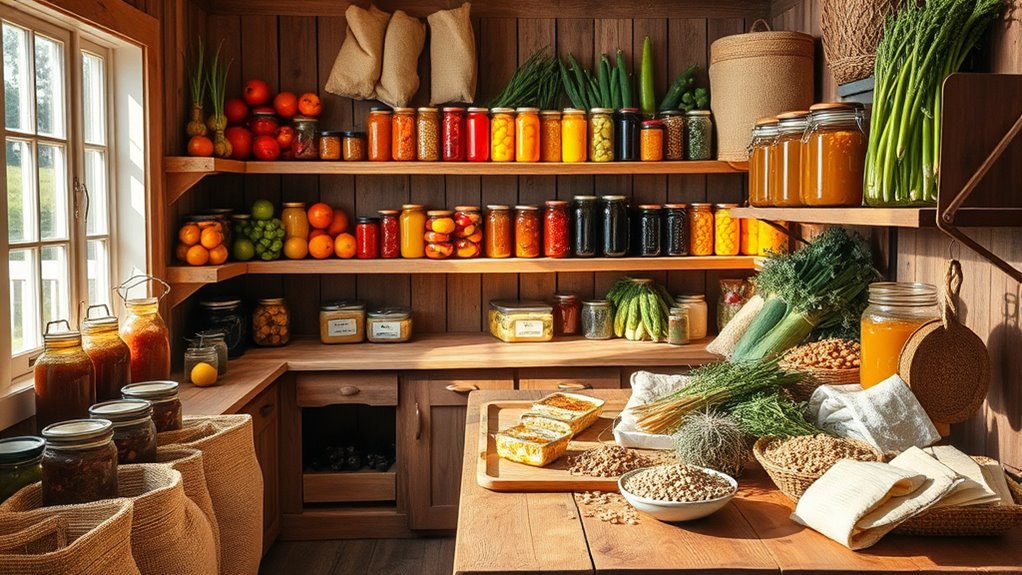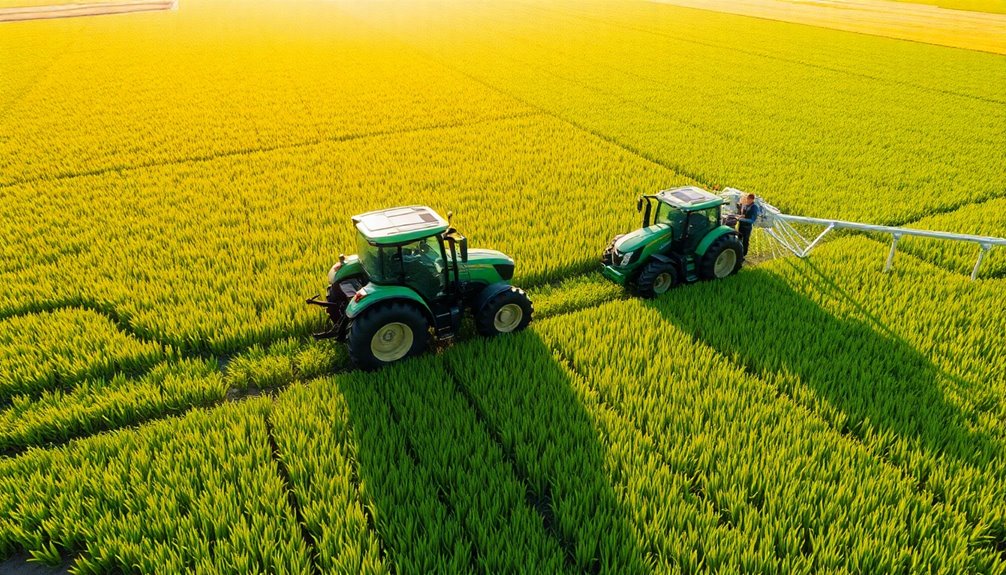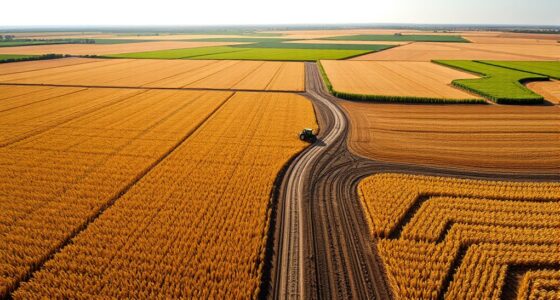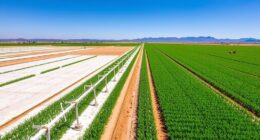Stocking your farm pantry is essential for ensuring food security during emergencies. Focus on non-perishable staples like grains, legumes, and canned goods with a long shelf life. Incorporate nutrient-dense items, like canned proteins and freeze-dried fruits, to maintain health. Use the FIFO method to rotate stock and avoid spoilage. With smart planning and regular inventory checks, you can create a reliable food supply for your family. Discover more strategies to enhance your pantry's readiness.
Key Takeaways
- Stock your pantry with long-lasting staples like grains, legumes, and canned goods to ensure food security during emergencies.
- Rotate your inventory using the FIFO method to prevent spoilage and maintain food safety.
- Regularly check expiration dates every 6 to 12 months to keep your pantry stocked with fresh items.
- Incorporate a variety of nutrient-dense foods, including canned proteins and freeze-dried fruits, for a balanced emergency diet.
- Utilize food preservation methods like canning and freezing to extend the shelf life of seasonal produce and meats.
The Importance of Stocking Your Farm Pantry
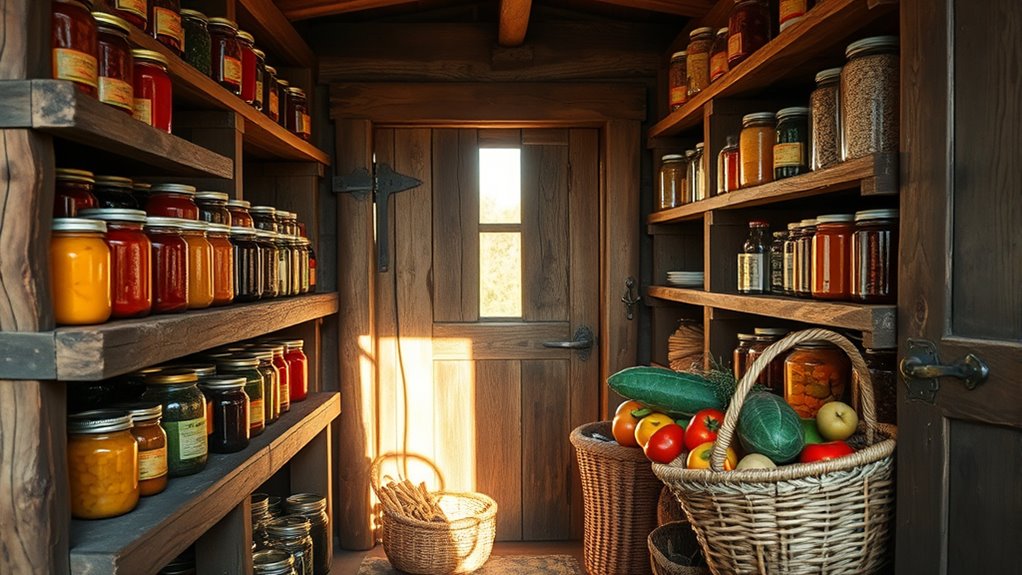
When emergencies strike, having a well-stocked farm pantry can make all the difference in ensuring your family's food security.
By focusing on long-term food storage, you can build a reliable supply that reduces your reliance on external sources. Stock your pantry with non-perishable staples like grains, legumes, and canned goods; these can last for years when properly stored.
Incorporate nutrient-dense emergency foods, such as canned proteins and freeze-dried fruits and vegetables, to keep everyone healthy during crises. Additionally, consider practicing sustainable foraging to supplement your pantry with fresh, wild foods when available.
Regularly check and rotate your pantry inventory to enhance food safety and prevent spoilage.
Don't forget to take into account dietary restrictions and special needs within your family, ensuring that everyone has access to suitable food options when it matters most.
Key Considerations for Emergency Food Storage
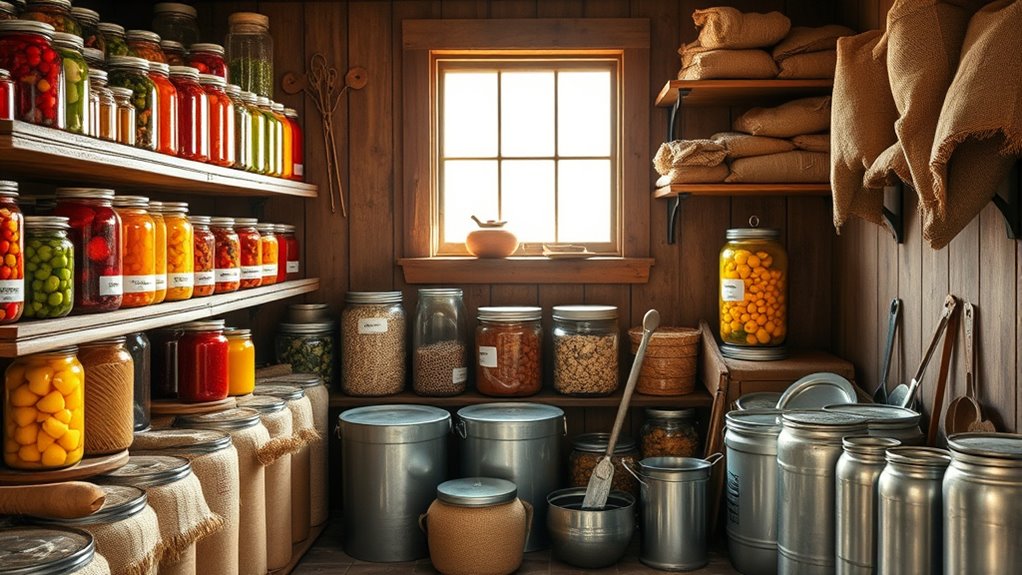
Nine key considerations can guide you in effectively storing emergency food for your farm pantry.
First, prioritize long shelf life foods that can last at least a year, like grains, legumes, and canned goods. Incorporate a variety of non-perishable items, including canned proteins and dry goods, to guarantee a balanced diet during emergencies.
Prioritize long-lasting, non-perishable foods for a balanced emergency diet, including grains, legumes, and canned proteins.
Use the FIFO method to rotate your stock, making sure older items are used before their expiration dates. Regularly check your pantry inventory every 6 to 12 months to assess expiration dates and overall conditions, preventing spoilage.
Finally, maintain an organized master list of stored items and update it frequently to streamline meal planning and shopping, avoiding unnecessary duplication. Additionally, consider setting savings goals to ensure you have the financial resources to restock your pantry when needed.
Essential Food Categories for Your Pantry
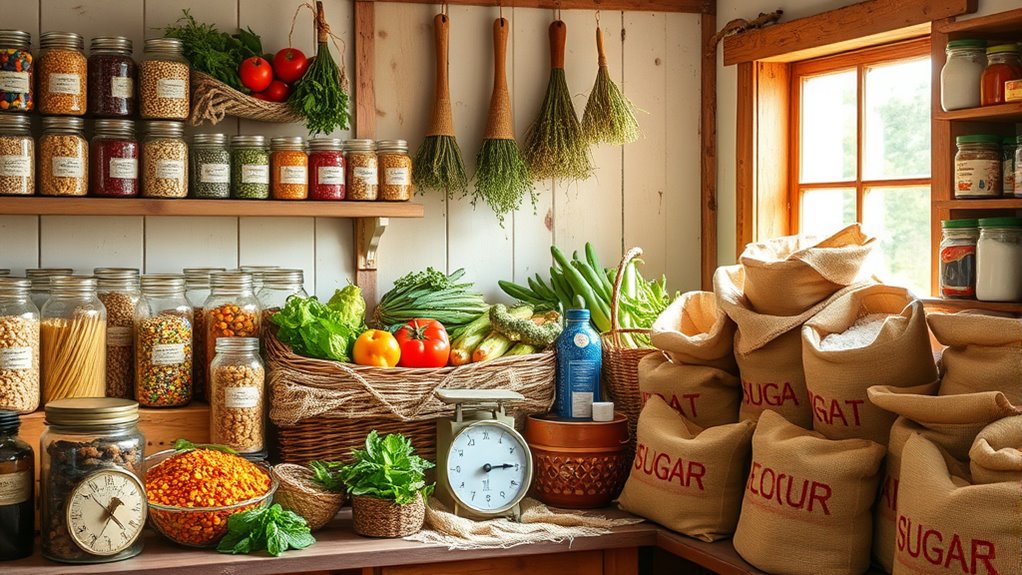
When stocking your pantry, focus on essential food categories that provide sustenance and variety. Grains, protein-rich legumes, and versatile canned goods should top your list, as they offer long shelf lives and can form the backbone of your meals. Additionally, consider bartering services or goods to acquire some of these essentials without straining your budget.
Grains for Sustenance
Grains are a cornerstone of any well-stocked pantry, offering essential carbohydrates and versatility for your meals. Long grain rice and pasta have impressive shelf life, lasting for years in airtight containers.
Quinoa and rolled oats aren't only nutrient-dense but also serve as a great source of protein and fiber, essential for maintaining energy during emergencies.
Whole grains like wheat berries and cornmeal can be ground into flour for baking, ensuring you've got fresh ingredients while extending their shelf life.
By incorporating a variety of grains into your pantry, you enhance dietary diversity, which is critical for overall health and morale during extended periods of food preservation. Additionally, including high-fiber foods like chia seeds can further support your energy levels and satiety during challenging times.
Keep these staples handy, and you'll be well-prepared for any situation.
Protein-Rich Legumes
While stocking your emergency pantry, don't overlook the importance of protein-rich legumes.
These nutrient-dense foods, like black beans and lentils, pack a powerful punch of protein, with cooked lentils offering about 18 grams per cup and black beans providing around 15 grams.
Their long shelf life makes them perfect for long-term storage, often lasting several years when kept in airtight containers.
Versatile and easy to prepare, you can use legumes in soups, stews, or salads, keeping meal options diverse and interesting during emergencies.
Incorporating these legumes not only bolsters your protein intake but also adds carbohydrates and dietary fiber, supporting your digestive health when you need it most.
Stock up on these essentials today!
Versatile Canned Goods
How can you guarantee your pantry remains stocked and ready for emergencies? Canned goods are your best bet.
These shelf-stable staples, including vegetables, meats, and fruits, provide essential nutrients and flavors that make meal preparation easy. They can last a long time, often beyond their best-by dates if undamaged, ensuring you have food when fresh options run low.
Be sure to check for spoilage, like leaking or dented cans, to stay safe from foodborne illnesses. Incorporate popular canned proteins such as tuna, chicken, and beans, which not only offer high nutritional value but also last at least two years. Additionally, consider stocking canned vegetables like corn and green beans, as they can serve as excellent side dishes and add nutritional variety to your meals.
A mix of versatile canned goods enhances meal variety and keeps you prepared for any emergency.
Strategies for Building a Long-Term Food Supply

Building a long-term food supply starts with smart planning and strategic purchasing.
Begin by buying staple items in bulk, like rice, beans, and canned food, ensuring they can last for years when stored properly. Incorporate preserving food techniques for meats and vegetables to extend their shelf lives and maintain nutritional value.
Start building your food supply by purchasing bulk staples like rice and beans, and use preservation techniques for longevity and nutrition.
Regularly check expiration dates every 6 to 12 months to keep your stock fresh and avoid expired goods. Organize your food storage using the FIFO (First In, First Out) method, which helps minimize waste by using older items first.
Finally, diversify your stockpile with high-energy, nutrient-dense foods such as nuts, grains, and dried fruits, ensuring a balanced diet during emergencies.
Growing Your Own Food: A Sustainable Approach
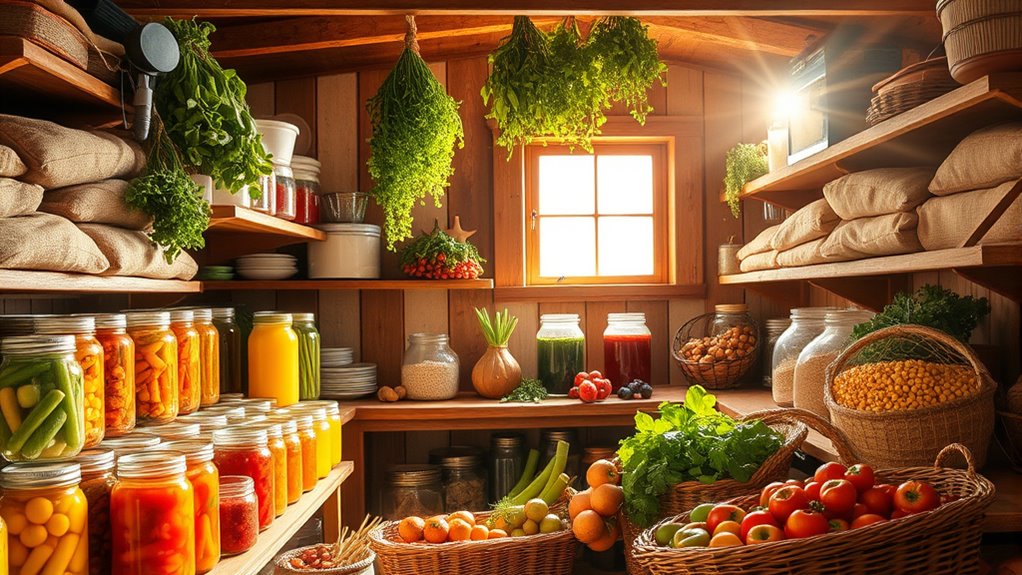
Growing your own food offers a sustainable way to boost your pantry while cutting grocery costs. Home gardens can yield fresh produce like tomatoes, cucumbers, and peppers, providing a continuous supply of nutrient-rich food throughout the growing season.
By implementing crop rotation and companion planting, you enhance soil health, creating a sustainable ecosystem that supports growth and pest control. Starting with heirloom varieties allows you to save seeds for future planting, ensuring a self-sustaining food source that adapts to your local conditions.
Even in limited spaces, using raised beds or vertical gardening can maximize your yield and sunlight exposure. Embrace this sustainable approach and watch your pantry thrive while saving money!
Preservation Methods for Seasonal Bounty
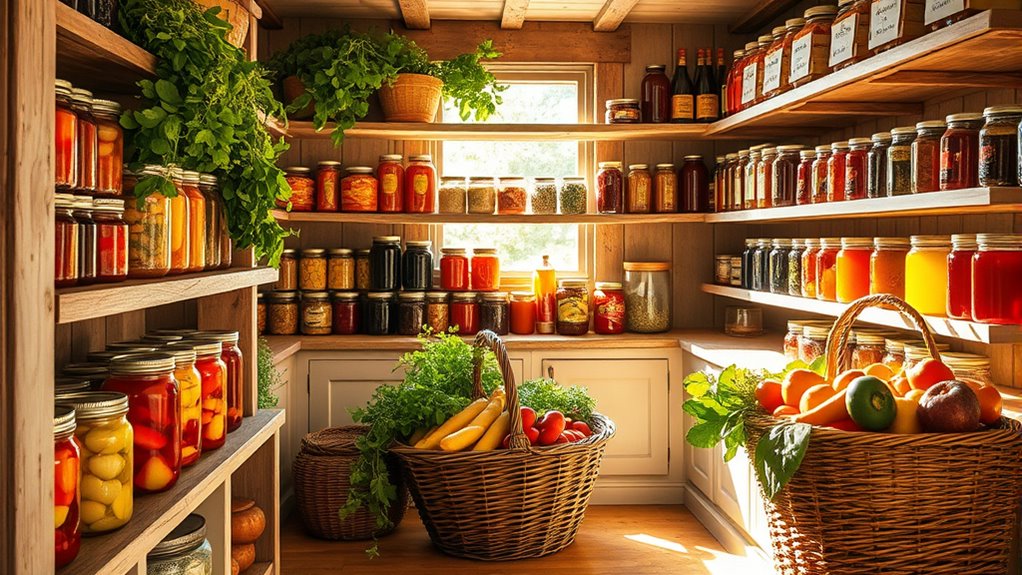
When it comes to preserving your seasonal bounty, mastering canning and freezing can make a big difference. Canning lets you store a variety of foods, while freezing helps maintain their nutritional value. These methods not only extend shelf life but also support your self-sufficiency throughout the year. Additionally, incorporating techniques like fermented vegetable plates can enhance the nutritional profile and flavor of your preserved goods.
Canning Techniques Overview
Canning offers a reliable way to preserve the seasonal bounty of your farm, allowing you to enjoy homegrown flavors long after harvest. This food preservation method involves sealing food in jars to create a vacuum, extending shelf life for over a year.
For high-acid foods like fruits and pickles, water bath canning is ideal. In contrast, low-acid foods such as vegetables and meats require pressure canning to reach necessary temperatures for safety. Always use proper canning jars and lids to prevent breakage under heat and pressure.
To maintain food safety, sterilize jars and lids by boiling them for at least 10 minutes. Following tested recipes guarantees you're using the correct techniques and processing times, preventing foodborne illnesses. Additionally, it's essential to consider investment strategies that protect your financial health while engaging in food preservation.
Freezing Seasonal Produce
Freezing seasonal produce is a fantastic way to capture the flavors of your harvest while preserving nutrients and texture. This method allows fruits and vegetables to maintain their quality for up to a year.
For vegetables, blanch them briefly before freezing to inactivate enzymes that can degrade flavor and color. You can freeze fruits directly, but wash, peel, and cut them first; a splash of lemon juice can prevent browning in apples and bananas.
Pack your produce in airtight containers or freezer bags, removing excess air to avoid freezer burn. Don't forget to label each container with the type of produce and freezing date to track freshness, ensuring you use older stock first with the FIFO method.
Best Practices for Buying in Bulk
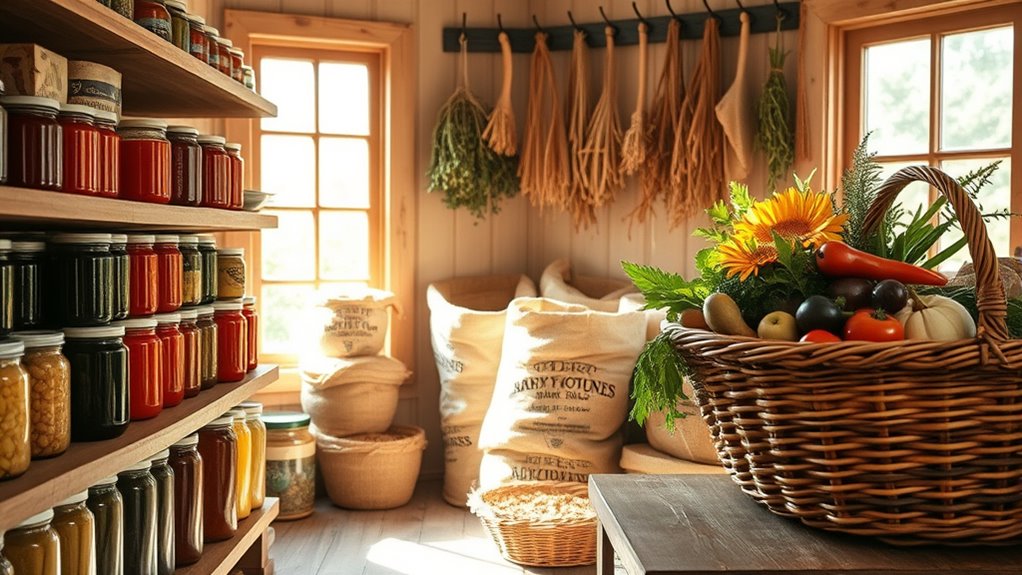
Buying in bulk can be a smart way to stock your farm pantry, especially when you focus on non-perishable items with long shelf lives.
Prioritize bulk foods like rice, pasta, and canned goods to secure your food supply. Take advantage of sales and promotions to save money while gradually building your pantry.
To maximize shelf life, use food-grade storage containers, such as 5-gallon buckets with oxygen absorbers, which can extend the freshness of your supplies up to 30 years.
Remember to implement the First In First Out (FIFO) method to rotate your inventory, ensuring older items are used first. Keeping track of expiration dates and contents will help you maintain an efficient and organized pantry. Additionally, consider incorporating long-term survival foods that offer both nutritional value and extended shelf life for optimal preparedness.
Maintaining an Organized Inventory

Effective organization is key to maintaining a well-stocked farm pantry. Start by creating a master inventory list that includes expiration dates and quantities of your foods. This helps you track what you have and what you need, minimizing waste and ensuring freshness.
Use a daily notebook to record purchases and organize your stock, preventing duplication. Investing in a label maker can streamline inventory management by clearly marking the contents of each container.
Regularly review your inventory at least quarterly to check for spoilage and prioritize older items. Ultimately, group similar items together on pantry shelves and label them for easy access, enhancing visibility and making meal planning a breeze. Additionally, consider incorporating daily care requirements for your farm animals into your inventory to ensure you have the necessary supplies on hand.
Incorporating Preserved Foods Into Daily Meals
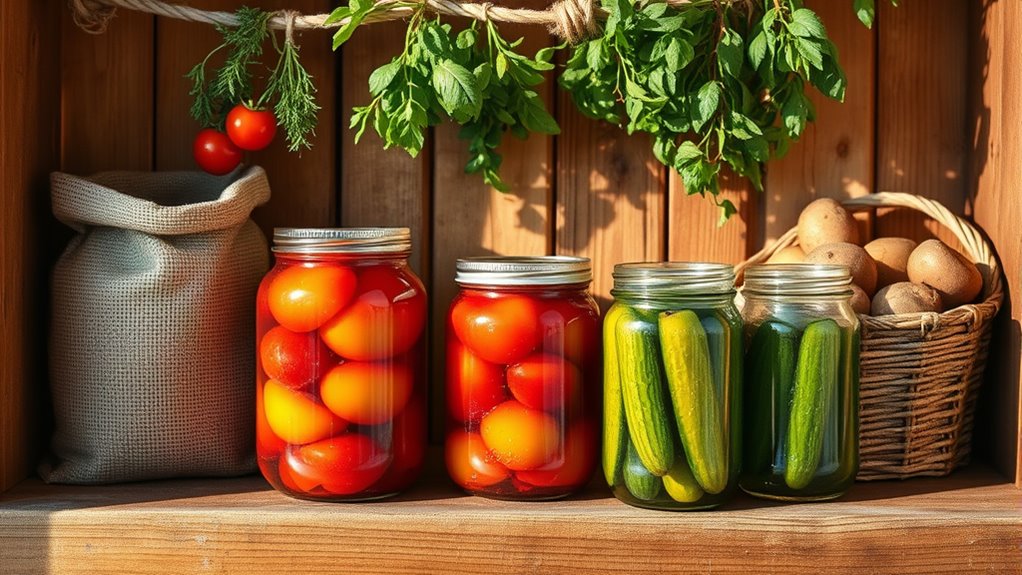
While it might seem challenging to incorporate preserved foods into your daily meals, doing so can enhance both nutrition and creativity in your cooking.
Start by adding canned veggies and legumes to soups and stews; they boost nutrition and make good use of your pantry stock. You can blend freeze-dried fruits into smoothies or oatmeal, packing in flavor and vitamins.
Incorporate canned veggies and legumes into soups for a nutritious boost, or blend freeze-dried fruits into smoothies for added flavor and vitamins.
For quick, nutrient-dense meals, combine grains like quinoa or brown rice with canned proteins like tuna or chicken. Hearty casseroles also shine with preserved ingredients, such as dehydrated potatoes and canned meats. Additionally, consider preparing Egg Rollup and Dumpling Sauce for a protein-rich breakfast option that utilizes your pantry staples.
Regularly plan meals featuring these preserved foods to reduce waste while ensuring a diverse diet, keeping your emergency supplies fresh and ready for use.
Frequently Asked Questions
How to Stock a Pantry for an Emergency?
To stock your pantry for an emergency, start by selecting a variety of shelf-stable foods, like grains, legumes, and canned goods.
Don't forget high-energy items, such as canned proteins and healthy fats, to keep your energy up.
Use a FIFO method to manage inventory, ensuring older items get used first.
Regularly check your stock every 6 to 12 months, and consider any special dietary needs in your household when stocking essentials.
What Items Should I Stockpile for an Emergency?
To prepare for an emergency, you should stockpile non-perishable foods like canned meats, grains, and legumes.
Don't forget about high-energy snacks such as nuts and trail mixes for quick nourishment. Include a variety of canned fruits and vegetables to keep meals interesting and nutritious.
Make sure to store enough water—aim for a gallon per person daily for at least three days.
Regularly check expiration dates and use the FIFO method to manage your supplies.
What Is the Longest Lasting Food for Preppers?
When you think about the longest lasting foods for preppers, you might picture something extraordinary.
Imagine freeze-dried meals that could last up to 30 years, just waiting for you to open them.
Canned goods can surprise you too, remaining safe for years if stored right.
Don't forget about grains like white rice, which can stick around for decades.
And then there's honey—indefinite shelf life!
You won't want to overlook textured vegetable protein either; it's got longevity covered.
What Should Be in a Survival Pantry?
In a survival pantry, you should stock long-lasting staples like rice, pasta, and legumes, which form the base for many meals.
Don't forget canned goods—vegetables, fruits, and proteins like tuna are essential for variety.
Also, include dehydrated and freeze-dried options for lightweight choices with extended shelf lives.
Aim for a mix of nutrient-dense foods, like nuts and seeds, and remember to regularly check your inventory to keep everything fresh and ready.
Conclusion
In the face of uncertainty, having a well-stocked farm pantry isn't just smart—it's essential. By preparing now, you're not just ensuring survival; you're embracing a lifestyle of self-sufficiency and resilience. Think of your pantry as your safety net, ready to catch you when challenges arise. So, take action today: grow, preserve, and organize. Your future self will thank you for the choices you make now, turning potential crises into manageable adventures.

